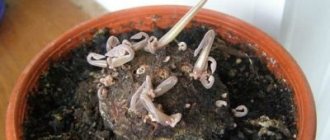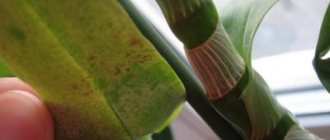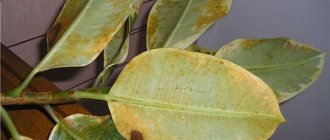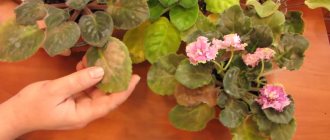Maintenance during the rest period
Cyclamen has faded, what should I do next and how to care for it after flowering?
After flowering (late spring), cyclamen begins a dormant period. There are several options for keeping the plant at this time. ATTENTION: As soon as the leaves begin to turn yellow, reduce watering, not allowing the earthen coma to dry out. The pot with the tuber is placed in a shaded, cool place. Another option for home care to preserve the tubers: after flowering, watering is reduced, and when all the leaves fall off, the pot with the plant is laid on its side
The roots do not die and, in order not to dry out the soil, cyclamen is sometimes watered
Another option for home care to preserve the tubers: after flowering, watering is reduced, and when all the leaves fall off, the pot with the plant is laid on its side. The roots do not die and, in order not to dry out the soil, cyclamen is sometimes watered.
After the cyclamen has gone to rest, its bulb cannot be stored in the refrigerator. Otherwise, after the end of the rest, he may not wake up. In order for cyclamen to come out of its “vacation” again, you just need to put it in a dark place, such as a balcony, basement, or simply put it under the bathroom.
During dormancy, it is recommended to water the plant no more than once every 2 weeks. Watering should be done with warm water containing phytohormones, and avoid getting it on the flowers, leaves and bulbs.
Watch a video about caring for cyclamens during the dormant period:
If the whole flower withers, how to treat it?
If you are late with timely care and the flower begins to wither, turn yellow and lose leaves, then you should immediately begin to resuscitate it. To do this you need:
- First, carefully examine the above-ground part of the flower and remove all dry, inanimate, affected parts.
- Treat the cut areas with any disinfectant.
- Then wash the tubers from the soil and, if necessary, carefully remove all questionable parts.
- Treat the tubers with Topaz or another fungicide.
- Then dry the roots and plant the flower in fresh, pre-calcined soil.
- Place in a dark place for several days, remembering to water moderately.
- After a week it can be returned to its normal place.
Read about the reasons why a flower withers and its leaves dry out in this article.
On the pages of our website we will also tell you about why the plant’s leaves curl or flower stalks dry out. Our experts will also give a lot of useful advice on how to save cyclamen from death.
Why does withering occur?
It is very important to learn how to choose the right flower when purchasing in order to avoid troubles in the future.
First of all, it is necessary to pay attention to the condition of the tubers. It is better to refuse the purchase if they are damaged
At the same time, the presence of rot on the roots is unacceptable. The tubers should be smooth in shape, and the leaves of the plant should not look sick.
When it comes to diseases of indoor plants, they are conventionally divided into parasitic and non-parasitic. In the first case, we are talking about the harm of parasites, in the second, about improper care of the flower.
Factors in the development of non-parasitic diseases are:
- excess moisture in the soil (learn how to save flooded cyclamen here);
- lack of air humidification in the room where the plant is located;
- incorrect choice of soil;
- inappropriate pot size;
- incorrect choice of location for the plant.
As for parasitic diseases, it is necessary to mention such pests as aphids, cyclamen mites and thrips:
- Aphids are among the most common parasites. It leads to complete deformation of the leaves and the plant, contributes to its depletion, taking away all the juices. Symptoms of the presence of aphids are white, gray, black, green or orange coating on the leaves of the flower. In order to eliminate aphids, you should spray cyclamen with an insecticide and then rinse it with jet water.
- Thrips are highly active. They are very bright and it is not difficult to identify them. They leave traces of their presence, which have a silvery tint. This inhibits the further growth of the leaves of the flower, as a result of which they may simply fall off. In order to eliminate thrips, you can use sticky tapes or insecticides.
- The cyclamen mite is microscopic in size, so it is very difficult to notice it on a flower. It parasitizes on the inside of the leaf. From the outside it seems that the leaves are covered with dust. The main difference is that it is very difficult to shake off such dust, and the edges of the leaves begin to curl. You can get rid of the parasite using chemical antiseptics.
Diseases and pests that cause yellowing and wilting of leaves
Why do monstera leaves turn yellow - diseases and pests
Yellowing of leaves is caused by pests such as:
- thrips are small insects that damage stems, leaves, and flowers. Their presence is indicated by the appearance of light spots, the leaves acquire a silvery tint;
- Cyclamen mites are small-sized pests that live on the underside of leaves. As a result of their vital activity, brown spots can be found on the flower. When infected, plant growth slows down, leaves turn yellow, curl and fall off.
Among the diseases, gray rot and late blight are the most active. The second disease appears due to waterlogged soil. If measures are not taken in time to save the flower, it will die. Gray rot is a fungal disease that affects the entire plant, which can cause it to die. The disease can be detected by a gray coating on the leaves.
Fusarium-affected cyclamen
What to do in this case?
First, you need to pinch off yellowed and dried leaves at the base, as well as dried flowers. In this case, you cannot use a knife or scissors; this can lead to further progression of cyclamen disease.
Advice! In order to preserve the plant, it is necessary to create the most favorable conditions for it.
If heating devices are used in the room, it is recommended to move the plant away from them. You should also avoid direct exposure to the scorching sun. On hot days, you can cover the flower tubers with ice. During the hot period, alpine violet will feel much better in a shady corner. If it happens that the cyclamen has been standing in the sun for a long time, then you can place the pot in a basin with cold tap water for 1-1.5 hours. This way the flower can be revived.
Sometimes cyclamen begins to turn yellow and dry out due to infection (read about the causes and treatment of cyclamen with yellowed leaves here). To get rid of the Fuzarium fungus, it is recommended to water the ground with a 0.1% solution of foundationazole or spray the plant with a 0.1% solution of a drug such as Topsin-M.
Wet rot can also lead to wilting, causing the plant to smell foul. Bacteria enter through cracks in the tubers. Quite often, infection occurs through the places where leaves are torn off. Sometimes infection can also occur through contaminated water or soil. A flower damaged by rot can be treated with an antiseptic, for example, crushed coal. In addition, the plant must be watered with settled water. In a situation where the infection was transmitted from another diseased plant, cyclamen cannot be saved. All that remains is to destroy the flower.
Natural causes
Sometimes it happens that cyclamen withers for completely natural reasons, that is, it enters a dormant period, which begins with the fact that the flower simply stops blooming. Gradually, the leaves of the alpine violet turn yellow, and then the entire above-ground part of the plant withers and dries out. During this period, it is recommended to gradually reduce the intensity of watering the flower.
After it has completely dried, the flower should be moved to a cool and shaded place. The plant will remain in this state for several months. After the woody plant begins to produce young leaves, it needs to be moved to a bright place and watered regularly.
It happens that the plant looks already withered and dead, in this case you can try to revive it. You should remove the rhizome from the ground and look at its condition. Even if the small roots have died, you need to feel the tuber - it must be elastic, otherwise the plant cannot be helped. It is necessary to wash the rhizome from the soil and treat it with a fungicide, for example, Topaz. Then dry it (for a short time) and plant it again in sterilized soil.
Important! The main thing is not to be late and then, perhaps, your flower will find a second life.
More information on how to save cyclamen when it dies can be found here.
How to save?
You can try to save the plant by taking the following emergency measures:
- Change the location of the potty. Move it to another room where the conditions are up to standard.
- Spray the butterfly flower with a stimulant. Usually this may be necessary after purchasing a flower and adapting it to new conditions.
- Add additional fertilizer to the cyclamen pot.
- If you see an obvious disease or notice pests, then dig up the tuber, free it from the remaining soil and replant the flower in good fertilized soil.
- The leaves can be treated with a medicine that is used to control pests. To have a positive effect, do this several times after a certain number of days. Approximately every 3-5 days.
Read about how to save cyclamen if it dies here.
So what to do if cyclamen turns yellow?
If the leaves of cyclamen begin to turn yellow, it is necessary, first of all, to inspect the plant for the presence of diseases or pests. It is worth carefully examining the surface of the tuber. If there are signs of rot, the tuber is pulled out of the ground, cleaned, and damaged roots are removed. The plant is carefully treated with a fungicide - a drug that destroys bacteria and fungal spores. The tuber is placed in different soil.
Rot can result from improper watering of the plant. Cyclamen loves frequent watering, especially during flowering. But they shouldn't be plentiful
Particular attention should be paid to the following point: water should not get on the tuber and growing point. If green or mold or an unpleasant, musty odor appears on the surface of the soil, the plant must be urgently transplanted into another soil. If cyclamen leaves turn yellow, the reason may lie in the presence of pests on the plant
If cyclamen leaves turn yellow, the reason may lie in the presence of pests on the plant.
Insecticides are used to eliminate them. These are chemicals designed to kill insect pests.
Why do cyclamen leaves turn yellow during flowering?
During flowering, cyclamen requires increased attention.
This is especially true for nutrition, because it is vital for the plant to receive all the necessary substances during this period. For this, complex fertilizers are best suited, capable of providing the flower with all the necessary elements. . They must be used strictly according to the instructions, while being guided by the principle “Do no harm”
Improper use of such drugs and an excess of fertilizer in the soil can cause an effect completely opposite to the expected one. With proper care, most often the question of what to do if the cyclamen turns yellow disappears by itself
They must be used strictly according to the instructions, while being guided by the principle “Do no harm.” Improper use of such drugs and an excess of fertilizer in the soil can cause an effect completely opposite to the expected one. With proper care, most often the question of what to do if the cyclamen turns yellow disappears by itself.
On hot days, if there is dry air, you can place the pot with cyclamen on a tray with small pebbles or peat. It is necessary to ensure that the tray is constantly moist. You can use small fountains or humidifiers. It is not recommended to spray cyclamen on the leaf. On sunny summer days, it is better to shade the windows and avoid direct rays hitting the flower.
These simple rules will help you avoid yellowing of cyclamen leaves during flowering and the growing season. All the troubles are completely worth it with the amazing beauty of this plant.
In this video you can learn more about cyclamen and the features of its care at home. Don't forget to ask and discuss.
Prevention
The most effective preventive measures aimed at preventing cyclamen leaves from turning yellow consist in properly organized care for it.
Additionally, you can do the following:
- when buying cyclamen, pay attention to the fact that it is healthy, richly blooming, with an abundance of beautiful green leaves;
- Whenever you purchase a new indoor flower, it is advisable to keep it separate from other plants (in quarantine) for a month, observing how it develops and whether there are any signs of disease;
- Regularly inspect cyclamen for diseases or attacks by insect pests and, if necessary, promptly eliminate dangerous manifestations.
What kind of plant is this?
The genus Cyclamen or Alpine violet from the Myrsinaceae family, sometimes attributed to the Primulaceae family and includes about 20 species. In fact, the correct name of the plant involves stress on the first syllable - cyclamen, and the generally accepted pronunciation comes to us from the French language.
The genus Cyclamen includes such plant species as perennial herbaceous plants, common in the Mediterranean countries; from Spain in the west to Iran in the east, as well as in Northeast Africa, including Somalia. Cyclamen is a perennial corm plant with beautiful patterned heart-shaped leaves and single flowers on long stalks. The flowers, up to 8 cm in diameter, have five petals and can be white, pink, purple, lilac and even violet.
On a note. Cyclamen leaves grow directly from the root, and pedicels appear from there, making the plant look like a lush bush.
Among the domestic species of cyclamen, varieties with green carved leaves are distinguished, on which an intricate pattern of light green color is visible.
Reproduction
Cyclamen can be propagated by dividing the tuber during transplantation. It is very good when a flower has a daughter tuber. It can be cut in half at the time of transplantation, after the dormant phase is completed. Each piece of tuber must have roots and at least one growth bud.
It is imperative to treat the cuts with brilliant green or sprinkle with crushed activated carbon. You can verify the effectiveness of this method by using it. He works.
Further care at home
If the cyclamen has faded, what to do next at home and how to care for it? Caring for cyclamen after flowering means proper watering and maintaining the right temperature.
You should pay attention to care during the dormant period, when the daytime temperature reaches 20°C. This period lasts from mid-April to September, during which time cyclamen does not bloom, its leaves dry out and fall off
Proper watering
It is enough to water the flower once a week; before the next watering, the top layer of soil must dry completely. After watering, the soil should be moist, but not soggy. You can only use purified or settled water.
Watering from a watering can
If the cyclamen has faded, what needs to be done next and how to water it:
- During the dormant period, watering is not stopped, it is reduced to 2-3 times a month;
- Water the plant with a small amount of water, depending on the size of the pot;
- After 2 months of rest, the amount of water is gradually increased in order to return to normal by the time of flowering.
Note! Cyclamen requires sufficient air humidity; in addition to watering, the plant should be periodically sprayed with water.
Feeding and fertilizers
For active growth and lush flowering, the plant needs to be fertilized.
Features of feeding cyclamen:
- For an adult flower, fertilizing is carried out 1-2 times a month until the buds form. As a fertilizer, you can choose liquid fertilizer “Floretta”;
- At home, you can prepare your own fertilizer by mixing 2 liters of water and 6 tbsp. l. wood ash;
- If the plant is young and still growing, you can feed it with calcium nitrate;
- It is better to minimize the use of mineral compounds; cyclamen does not tolerate high concentrations of salts;
- The use of chloride fertilizers is not allowed;
- Fertilizer should be applied only to moist soil;
- It is undesirable to use complex fertilizers for deciduous plants, otherwise foliage will begin to actively grow instead of buds;
- After flowering, all fertilizing must be stopped.
Note! If cyclamen was grown from seeds, it must be fed with growth activators immediately after the formation of the first shoots
Lighting
Cyclamen is a light-loving plant; it needs bright, diffused lighting. It is advisable to avoid direct sunlight, as this will cause the leaves to dry out and fall off. The plant can stand near a window on the east, west and southwest sides. In the morning and evening, it is allowed to place the flower on the windowsill near the south window.
Pots on the windowsill
Note! During dormancy, the plant gets used to the darkness; you cannot immediately place it in a lighted place. Cyclamen should stand in partial shade for 3-4 days to get used to the light again.
Temperature
One of the common questions from indoor flower owners is “If the cyclamen remains in the pot after flowering, what should you do with it and at what temperature should you store it?” The plant feels good at daytime temperatures from 10 to 18°C and night temperatures within 6-9°C. During the heating season, cyclamen should be kept away from radiators and heaters.
During the dormant period, the flower should be kept indoors at a temperature of 15-20 ° C; it can be stored in basements, cellars or in an air-conditioned room. If in the hot summer it is not possible to provide the required temperature, storage in the refrigerator is allowed. The plant is dug out of the soil, the roots are wrapped in polyethylene and placed in the lower section for storing vegetables.
Primroses require special conditions; in unfavorable conditions, they will not bloom. If the leaves of cyclamen quickly turn yellow, or the plant looks sick, it is necessary to immediately provide assistance. Incorrect or untimely actions can ruin the flower.
Causes
In nature, most types of cyclamen grow in the mountains, where the air is always humid and cool, and the sun's rays are bright but not scorching. This is their natural comfortable environment, promoting long and colorful flowering. It is very difficult to create such a microclimate at home, so sometimes the flower begins to act up, shed leaves, and even get sick. Most often, a change in the color of the leaves of a plant occurs for the following reasons.
Dry and warm air
At home, cyclamens bloom in winter, somewhere from December to March, when central heating is used to heat the premises. This is the main reason why the leaves of the plant begin to turn yellow and dry out. The ideal temperature for cyclamens to bloom is +15–16 °C. If the temperature in the room rises above +20 °C, the flower feels uncomfortable, which is signaled by a change in the color of the leaves. A sign that the air in the house is not humid enough is the yellowing of the leaves, along with which the flowers remain strong and continue to bloom.
Violation of the watering regime
Another reason why cyclamen turns yellow is improper watering (insufficient or, conversely, excessive). To avoid extremes, water the plant as needed, allowing the top layer of soil to dry out. If you do this more often, fungi and mold will begin to develop in the wet soil, and the flower can only be saved by replanting it in a new substrate. When watering, you need to make sure that moisture does not fall on the growing point. For these reasons, it is better to pour water along the edge of the pot or into the pan.
Lack of feeding
Cyclamens need to be fed throughout the entire period of growth and flowering, using mineral complex fertilizers for flowering plants, sold in any flower shop. Before the formation of buds, fertilizing should be done 1 time/2 weeks, and with the beginning of flowering every week, otherwise the lack of nutrition will immediately affect the color of the leaves.
Flower growers often complain that a flower may turn yellow soon after it has been purchased.
Video “Cyclamen from the store”
What to do after purchasing cyclamen.
https://youtube.com/watch?v=ybjlQKHevhE
The real reason for this phenomenon is also lack of nutrition. Now flowering plants in pots can be bought at any time of the year, which is unnatural for cyclamen. They are forced to bloom with the help of stimulating drugs that are regularly sprayed on the leaves.
Natural process
There is no need to worry about why the cyclamen leaves turned yellow if this happened in spring or summer. During this period, the plant enters a dormant phase and sheds its leaves for a natural reason. The fact that the home flower is going into a dormant state is evidenced by the gradual withering of the leaves, starting from the lower tiers. First the leaf becomes pale, then yellow, after which it begins to dry out and fall off.
If the leaves do not fall off on their own, they are cut off or twisted at the base, and the pot with cyclamen is transferred to a cool, dry place where it can recover. No fertilizing is applied during this period, and watering is severely limited. Some gardeners dig up a tuber during the dormant period, and at the end of summer plant it in a new substrate. With this method, the plant develops faster and can bloom within 2–3 months, provided the tuber is stored correctly.
What kind of flower is this?
ATTENTION: In specialized sources, this plant is called Alpine violet due to its wide distribution in the Alps. People often call the flower “pork bread” or “dryakova”
The homeland of cyclamen is the Mediterranean coast (countries of Southern Europe, Central Asia).
Among the features of the plant are rich green leathery foliage, a decorative silver pattern on its surface, the original shape of the flowers and fringed petals. The color palette is extensive: from snow-white hybrids to burgundy flowers. The flowering period reaches 3 months. At home, cyclamen blooms in autumn or spring.
This is interesting: European cyclamen - description, properties and care rules
How to choose a plant?
Choosing a plant for your home should be taken seriously. If a flower exhibits even slight yellowing of the stems or leaves, it is better to refuse to purchase it. This is due either to the presence of a serious illness or to improper care in the store. The article below provides information about the reasons why cyclamen leaves turn yellow.
What to do to ensure successful adaptation at home? A flower in a pot should be purchased at the moment of flowering
When purchasing tubers, you must pay special attention to their weight and appearance. Smooth, heavy, wrinkle-free and scratch-free tuber with live buds - good quality
During the period of adaptation at home, even with a seemingly good specimen purchased in a store, problems may arise. Cyclamen leaves turn yellow especially often. What to do? After all, he immediately becomes not very attractive.
Improper care as the cause of yellow leaves
Persian and European cyclamens are most often grown at home. The flowering period of these varieties begins at different times: the European one begins to bloom in the warm season, and the Persian one, starting in October.
Temperature
If yellowing of the leaves occurs while maintaining the freshness of the buds, then you should pay attention to the temperature in the room. The optimal temperature for this flower is 12-15 °C. If it drops below 10 °C, the plant may die
However, if the regime has crossed the upper limit, the leaves begin to turn yellow, dry out and fall off. It is recommended to take the flower pot to a cooler room and away from the central heating radiators.
Flowering cyclamen leaves turn yellow most often due to the temperature in the room
Humidity and lighting
Compliance with the conditions will allow you to grow a beautiful flower. To do this, humidity must be within 50%. If it rises to 80%, then there is a risk of infection with cyclamen mites, and if it is low, it leads to the appearance of red spider mites. You can save the plant in the following way: you need to spray water near it from a small spray bottle, but in such a way that it does not fall on the flower itself. You can increase air humidity using wet expanded clay, which can be poured into the tray of the pot.
Note! The flower should not be in a draft, but it is worth making sure that there is good air circulation in the room with it. In this case, you can place the pot with the plant closer to the wall
There is enough natural light for the flower. Cyclamen loves soft, diffused light. When the leaves are exposed to direct sunlight, they begin to turn yellow and can get burned. In summer, it is worth keeping the flower on the east side, and in winter, move it to the south.
Watering
Cyclamen loves moist soil, but you should know certain nuances:
- water should be at room temperature;
- it is necessary to water the flower regularly;
- do not allow drops to fall on the tuber and leaves;
- the water should stand for at least 24 hours;
- It is worth watering slightly dried soil;
- It is necessary to drain the water from the pan after watering.
If the soil is always too wet, the roots may begin to rot and mites may develop. However, cyclamen also does not like dry soil and reacts to it by yellowing of the foliage. If it becomes overwatered, it is worth replanting the flower in a new pot.
Damage to cyclamen disease
How to properly care for cyclamen
The house must have an ideal environment for cyclamen if you want to grow a healthy flower. The optimal temperature for it is 12-15 °C. It needs diffused bright light. Air humidity should be within 50%. Its level can be maintained by spraying. It is worth ventilating the room often, but do not place the pot of cyclamen in a draft.
Important! Proper and timely feeding will also help keep the flower in good health. The rule here is that it is better to underfeed than to overfeed.
Preventing diseases at home
The best way to treat diseases is to prevent them. There are a lot of options on how to maintain the health of a flower. The main treatment is considered to be with solutions such as:
- potassium permanganate;
- copper sulfate;
- phytosporin.
They will help strengthen the plant and prevent the occurrence of diseases. It is also recommended to water the plant in the morning so that the soil has time to dry out a little during the day.
Replanting cyclamen
You can save your favorite houseplant in any case if you notice the signs of poor health of the flower in time. Cyclamen shows malaise with yellow leaves, and therefore it is worth paying attention to this sign.
Diseases
Some diseases can turn your little cyclamen into a bush with yellowing leaves and wilting flowers. Diseases affect the plant during the growth period - in winter. Most of them cannot be treated, and gardeners recommend throwing away the diseased plant before the disease spreads to healthy ones.
Fusarium wilt
Fusarium rot causes rapid wilting. It immediately attacks the roots and moves through the xylem of the plant. It is very specific; certain types of fusarium rot infect only cyclamen. Therefore, pots after flowers that have been exposed to this disease must be disinfected or replaced with new ones.
Conditions for its appearance: very warm air with a temperature of +23–35° C and excessive humidity (75–80%). Rot bacteria may be present in the soil but not appear as long as the soil is dry. The first symptom of fusarium rot is that cyclamen leaves turn yellow and wither.
Remove the plant from the pot and inspect the roots. If you cut the stem or tuber of such a flower, you will see that it is colorless inside. Discoloration is a sign that a flower must be thrown away, just like those that were next to it. Before planting the tuber, use fungicides labeled “Against Fusarium rot.”
Gray rot
Gray mold is caused by the fungus Botrytis, which appears when the center of the plant is over-watered. Additionally, insufficient air circulation creates an optimal environment for the development of the fungus. This type of rot develops at the base of stems and quickly attacks flower buds and leaves. All affected parts should be removed and discarded, and the plant should be moved to a room with better air circulation. If the flower is heavily infected, it is better to throw it away.
Important! Tubers contain various substances, including saponins - plant poisons. They can cause poisoning, so keep cyclamen away from children. The degree of poisoning depends on the amount ingested
The degree of poisoning depends on the amount taken orally.
To improve air circulation, you can install a fan after removing all damaged parts of the cyclamen. Try to avoid getting water on the leaves or crown when watering. Erwinia bacteria are responsible for soft rot. The cyclamen turns yellow, the leaves fade, and the tuber becomes soft. This problem occurs if the tubers are planted too deep and the soil mixture contains a lot of moisture, a lot of heat and a lot of fertilizer. It is also better to throw away the affected plant.
Wood ash can prevent gray rot. But if the plant is severely affected, then fungicides are used. "Fitosporin M" is a natural bifungicide that contains the bacteria Bacillus subtilis. Developing in the soil, they destroy pathogenic microflora, including bacteria that cause gray rot. The drug not only treats, but also improves the condition of the soil and increases the resistance of cyclamen to diseases. If you purchased the drug in liquid form, you do not need to dilute it. Use according to package instructions.
Causes and signs of damage
Various influences can lead to flower damage. Experts note that the reasons leading to plant damage are most often the following:
- waterlogging of the soil in which the flower is located;
- incorrectly selected room temperature;
- irrational watering;
- decrease in humidity;
- incorrectly selected soil substrate;
- reduced insolation.
Each of these factors causes the appearance of cyclamen to change. Thus, an increase in air temperature in the room where these flowers are located leads to their beautiful buds falling off. And also such a change in the microclimate can cause the leaves to begin to dry out.
Lower temperatures can also damage the plant. You can suspect negative changes in a flower if you carefully observe it. So, if a blooming cyclamen suddenly drops its buds, then in this case you should definitely evaluate the temperature in the room where it is located. If this decorative flower is frozen, then urgent measures must be taken to help protect it from death.
Proper watering is an important condition for good plant growth. Some (especially beginner) gardeners are afraid of drying out cyclamen and water it quite often
Such frequent watering, as a rule, leads to damage to the root apparatus of an indoor flower. If the flooded cyclamen begins to rot, then watering should be significantly reduced. Moreover, after overwatering, the plant requires careful care.
If cyclamen withers, then it is necessary to evaluate the humidity. Cyclamen is a plant that withers and dies in too dry air. Experts also recommend that cyclamen lovers think about changing the humidity if the flowers have drooped.
If the leaves of this decorative flower curl, then experts recommend that you definitely evaluate the humidity in the room. Too dry indoor air quite often leads to such specific changes. If it is not possible to change the humidity in the room with the flower in time, then with a high degree of probability its owner will have to note with regret in a few weeks that his pet has completely withered and dried up.
Various parasites can also cause flower damage. Microscopic pathogenic fungi settle on cyclamen foliage, leading to a change in its appearance. In some diseases caused by parasites, affected leaves curl down and turn pale. A characteristic white coating may also appear on the foliage.
Options for flower resuscitation
It is possible to revive and save a flower only in the early stages of damage, when there are no serious deformations of the stem and foliage.
Leaf with pests
What you need to do to preserve cyclamen:
- Determine the disease and its cause. For example, the problem is stagnant moisture, poor-quality soil or high temperature;
- Remove damaged parts of the flower: leaves, stems, damaged roots;
- The surviving parts are treated with a solution, the choice of which depends on the disease of the plant;
- If the problem is in the soil, replanting into a new high-quality substrate will be required;
- The plant continues to be looked after, watering, temperature and lighting are controlled.
If cyclamen leaves curl due to pests, the problem must be eliminated.
You can fight pests with folk remedies or insecticides, which is better to use:
- Chemical agents will help get rid of aphids: Aktara, Fitoverm, Agrovertin. The leaves are treated with a cotton swab dipped in the solution, after which the plant is washed in the shower;
- When choosing chemical preparations, it is necessary to take into account that mites are not insects, and conventional means will not help. Acaricides Neoron and Sunmite will help to overcome the pest;
- Solutions of Aktara, Fitoverm and Bankol, which need to be used to treat the leaves, will help get rid of scale insects. Adults have the ability to fly to different bushes, so treatment is carried out every 14-30 days;
- In the fight against thrips, it is better to prevent their appearance. It is necessary to maintain normal humidity and air temperature, especially in summer. If insects are infested, the chemicals Akarin, Fitoverm and Agrovertin will help get rid of them.
Young flowers do not rest in summer and bloom profusely; for adult plants, rest in the hot season is of great importance. If you do not give cyclamen a rest, natural rhythms are disrupted. To make cyclamen bloom next season, you need to get rid of problems and properly care for it.
Why leaves turn yellow - all sorts of reasons
Cyclamen leaves periodically turn yellow - this problem is sometimes encountered by plant owners. The cause of yellowing leaves is usually due to improper care and violation of maintenance conditions.
A possible cause of yellowed leaves of a home flower may be:
- Unsuitable temperature. Cyclamen is a cold-loving plant, so it does not tolerate high temperatures. It feels comfortable at temperatures ranging from +14C to +16C.
- Incorrect lighting. Insufficient lighting or direct sunlight on the flower can lead to yellowing of the leaves.
- Errors in watering and humidity levels. Excess or lack of moisture can immediately affect the plant. Cyclamen prefers moist air - too dry indoor air can cause yellowing leaves.
- Feeding errors. Lack or excessive feeding of the plant with fertilizers high in nitrogen can also cause yellowing of cyclamen leaves.
- Rest period. After abundant flowering, the plant prepares for rest and during this period the natural process of wilting begins: the leaves gradually turn yellow and dry out.
- Untimeliness and errors in transplantation. Cyclamen is replanted only before flowering. A prepared mixture of sand, leaf humus and turf soil is perfect for replanting. The rotten part of the tuber should be removed.
From the video you will learn why cyclamen leaves turn yellow in winter:
Description
Cyclamen (alpine violet, dryer) is a fairly common flower among home flora lovers. Its inflorescences are distinguished by their tenderness and originality, capable of decorating any home without exception. An additional advantage is that cyclamen blooms in the autumn-winter season, when other plants “rest”. However, caring for this perennial flower is very difficult.
Reference! Alpine violet is a bush plant. It has dark green leaves that are round or heart-shaped. They are distinguished by a juicy and rich shade (orange, pink, purple), and they are located on red petioles.
Sunburn
Housewives think that cyclamen needs sunlight. However, its excess can also be harmful to the plant. When placing cyclamen, you need to avoid direct sunlight, which can leave burns on the leaves.
It is better to choose a place where the cyclamen will not be exposed to the bright midday sun. There is no need to move the pot too close to the glass.
Sunburn is different from normal yellowing. The peculiarity is that they will stop appearing if you remove the cyclamen in the shade.










